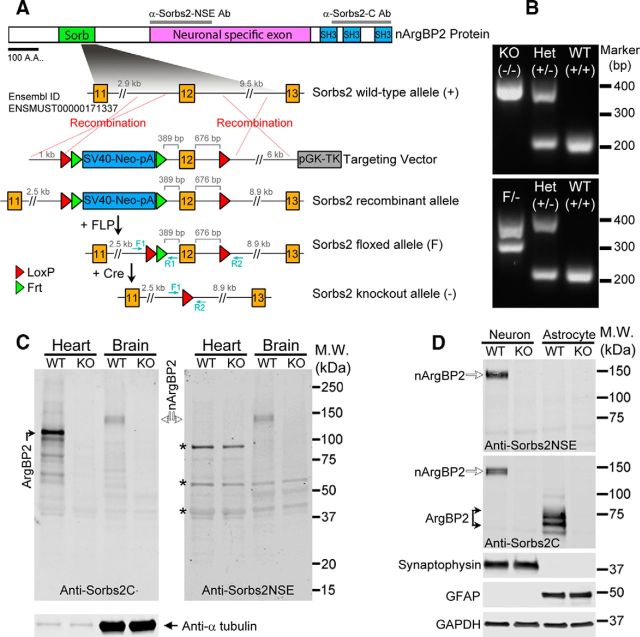Figure 3.
Generation of Sorbs2 floxed and KO mutant mice. A, Exon 12 that encodes part of the Sorb domain was selected for targeting. Thymidine kinase driven by mouse phosphoglycerate kinase 1 promoter (pGK-TK) was used for negative selection; neomycin resistance gene driven by the SV40 promoter (SV40-Neo) was used for positive selection. Transgenic mice expressing germline transmittable FLP and Cre recombinase were crossed with mice containing the Sorbs2 recombinant allele to generate Sorbs2 floxed allele (F) and KO allele (−). Primers F1, R1, and R2 were combined for detecting Sorbs2 mutants and WT. B, PCR genotyping for Sorbs2 mutants and WT mice. C, Immunoblots show the complete absence of ArgBP2 and nArgBP2 proteins in heart and brain tissues from Sorbs2 KO mice. Left, Anti-Sorbs2C antibody recognizes both ArgBP2 (black arrow) and nArgBP2 (open arrows). Bottom, Anti-α tubulin antibody reveals that similar amounts of proteins were loaded between genotypes. Right, Same amount of tissue homogenates was also probed with anti-Sorbs2NSE antibody. Bands labeled by asterisks were recognized by anti-Sorbs2NSE antibody in both genotypes but not detected by anti-Sorbs2C antibody, suggesting that they were nonspecific signals. D, Immunoblots show that nArgBP2 is exclusively expressed in neuronal cultures, whereas ArgBP2 is only detected in astroglial cells. Both nArgBP2 and ArgBP2 were depleted from neuronal and astroglial cultures derived from Sorbs2 KO mice. Antibodies against synaptophysin and GFAP were used as markers for neurons and astrocytes, respectively. Anti-GAPDH antibody revealed that similar amounts of proteins were loaded for each lane.

